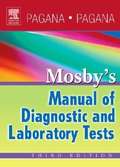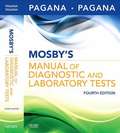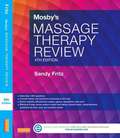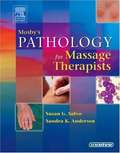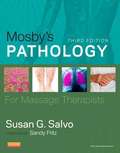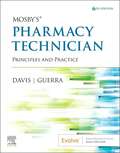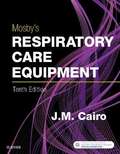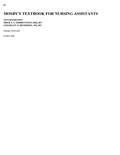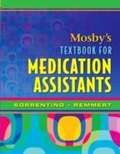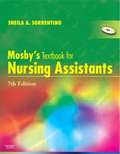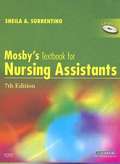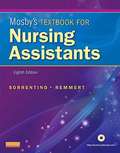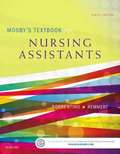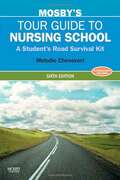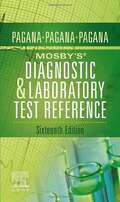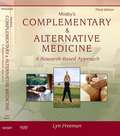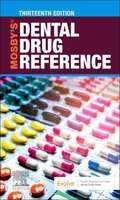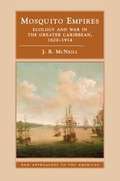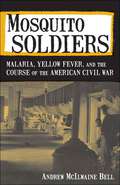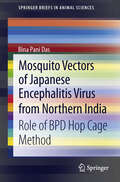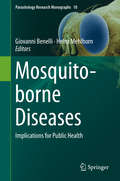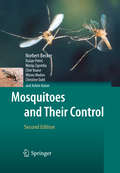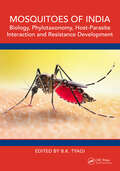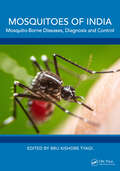- Table View
- List View
Mosby's Fundamentals of Therapeutic Massage (4th edition)
by Sandy FritzFritz, director of the Health Enrichment Center at the School of Therapeutic Massage and Bodywork in Lapeer, Michigan, offers a highly visual, entry-level book for students and practitioners of massage therapy. The design and plan of the book correspond to the publisher's Mosby's Essential Sciences for Therapeutic Massage, also by Fritz. This fourth edition contains increased material on body mechanics, nutrition, career tracks, insurance reimbursement, and complementary techniques. This edition also integrates skills in research literacy, and emphasizes skills necessary to work with supervision within the mainstream healthcare system. Learning features include outlines, key terms, and summaries, plus chapter-ending workbook sections with matching and labeling exercises and exercises in problem-solving and record keeping. Twenty case studies from fitness, sport, spa, and medical settings are provided.
Mosby's Manual of Diagnostic and Laboratory Tests
by Kathleen Deska Pagana Timothy J. PaganaThe 700 laboratory and diagnostic tests in this reference are divided into 12 sections according to the body fluid analyzed or the type of scan performed. Each entry explains the basic pathophysiology behind the test, summarizes patient care and the procedure, and lists normal findings, critical values, indications, contraindications, potential complications, interfering factors, the clinical significance of test results, and related tests. The fourth edition adds 30 studies including breast cancer genomics, intravascular ultrasound, computed tomography of the heart, and platelet closure time.
Mosby's Manual of Diagnostic and Laboratory Tests
by Kathleen Deska Pagana Timothy J. PaganaWidely used in both academic and clinical settings, this comprehensive resource provides clear, concise coverage of more than 700 of the most commonly performed diagnostic and laboratory tests - including 30 new to this edition. Chapters are organized by test type and begin with a list of the tests covered, followed by a test type overview with specimen collection techniques. Tests are presented in a consistent format with normal findings, indications, test explanation, procedure and patient care, and test results and clinical significance, as well as any applicable contraindications, potential complications, interfering factors, and related tests. A full-color design and 127 photographs and illustrations depict procedures, equipment, techniques, and key concepts. Provides comprehensive coverage of more than 700 diagnostic and laboratory tests routinely performed today. UNIQUE! Test Results and Clinical Significance sections explain pathophysiology and how test results may indicate certain disease processes. Color-coded thumb-tabs, alphabetically organized chapters, and two appendixes that list all tests - one in alphabetical order and the other organized by body system - make every test easy to find. Critical Values alert you to situations requiring immediate intervention. UNIQUE! Related Tests sections list tests that provide similar information or are used to evaluate the same body system, disease process, or symptom. UNIQUE! Clinical Priorities boxes emphasize information that must be kept in mind when preparing a patient for testing, performing a test, and evaluating results. UNIQUE! An icon for drug-related Interfering Factors alerts you to the effects of pharmacologic agents on tests. A patient teaching icon indicates information that should be shared with patients and their families. Home Care Responsibilities boxes provide important patient teaching guidelines and instructions for patients outside the acute care setting. UNIQUE! Age-Related Concerns boxes address the special needs of pediatric and geriatric patients and critical age-related variations in values. SI units are included in the Normal Findings section of appropriate tests. Convenient lists of disease and organ panels, test abbreviations, and tests by body system offer quick access to frequently referenced information. A comprehensive index includes the names of all tests and their synonyms, as well as other relevant terms found within test entries for quick access in the clinical setting.Completely updated content with 30 new tests, including ductoscopy, thyroglobulin, lactoferrin, and human papillomavirus. New full-color photographs and enhanced illustrations clarify key concepts and demonstrate testing techniques.
Mosby's Massage Therapy Review, 4th Edition
by Sandy FritzWritten by massage therapy expert Sandy Fritz, this unique review resource prepares you for all of your massage therapy exams - both routine semester exams and tests administered for licensure, such as the National Certification Exam and the MBLEx. This comprehensive review features updated content and questions based on the currently administered licensing exams. Plus, a companion Evolve website comes loaded with 8 practice exams and a variety of review activities such as labeling exercises, crossword puzzles, electronic coloring book, games, and much more! And for studying on the go, Mosby offers a new mobile app featuring 125 test questions. No other massage review on the market gives you such complete exam preparation! Full color format with 347 illustrations (showing various massage techniques as well as anatomy & physiology) presents information in a more visual, engaging way and helps you retain information better than reviewing text alone. Over 1300 practice questions in the text provide the opportunity to assess your readiness for exams. Over 40 labeling exercises are available throughout the book to help kinesthetic learners retain information. Logical text organization presents review content with illustrations and examples followed by review questions and exams to help you hone test-taking skills as you master facts, learn how to apply them, complete practice questions by topic, and then work through a realistic exam experience. Written to be versatile so it can be used to prepare for licensing exams, as well as classroom exams allows you to prepare for massage licensure exams as well as your regular course load along the way. Answer key printed in the back of the text with rationales provides you additional feedback so you can better understand why answers are correct or incorrect. Esteemed author Sandy Fritz delivers quality content that students and instructors know they can rely on. NEW! Updated content and questions based on the changes to licensing exams delivers the most up-to-date, relevant questions ensuring you'll be fully prepared to pass the current exams. NEW! Companion website offers 8 practice exams, numerous review activities such as labeling exercises, crossword puzzles, Body Spectrum electronic coloring book, online flashcards, med term games, animations and more. NEW! Mobile app with practice test questions offers increased flexibility to study on the go and in shorter intervals.
Mosby's Pathology for Massage Therapists
by Susan G. Salvo Sandra AndersonMore than just a compendium of diseases, this comprehensive guide is an essential resource on pathology and pathophysiology that helps students adapt their technique to ease pain and discomfort, promote healing, and avoid treatment when contraindicated. Ideal as a learning tool or as a handy quick reference, this highly illustrated resource provides discussions of more than 300 pathologies and conditions organized by the body system. Taking the reader through health assessment and client consultation, this outstanding textbook also covers sanitation procedures and hygiene, as well as general contraindications and endangerment sites.
Mosby's Pathology for Massage Therapists, Third Edition
by Susan G. SalvoWritten by a massage therapist for massage therapists, Mosby''s Pathology for Massage Therapists, 3rd Edition provides direct information along with focused recommendations. Coverage of over 340 pathologies helps you appropriately tailor massage treatment, and more than 750 full-color photographs and illustrations make it easier to recognize common pathologies. This edition includes a new chapter on geriatric massage and has been extensively reviewed by over a dozen experts in the massage and medical fields. Written by massage therapy educator and practitioner Susan Salvo, this resource provides the pathology knowledge you need to succeed on licensure and certification exams and in practice. A traffic light icon appears before each pathology in the book, designating whether massage is contraindicated (red), local contraindication (yellow), or indicated (green) for that particular pathology. Consistent format for each chapter makes it easy to find key information with learning objectives, list of pathologies, system overview, and pathologies, including description, etiology, signs and symptoms, treatment, and massage considerations. Student-friendly features in each chapter include learning objectives and self-tests that measure your comprehension. Medical Technology boxes highlight special populations, such as clients in wheelchairs or with pacemakers, and explain what the medical device is, and what special precautions or contraindications you should be aware of before working on these clients. Spotlight on Research boxes summarize recent studies of massage therapy and its effects. Student resources on an Evolve companion website include interactive activities, video clips of techniques, animations, the Body Spectrum coloring book, flashcards, review questions, additional case studies, an image collection, an audio glossary, study tips, stress-busting tips, research updates, and more. Mosby''s Pathology for Massage Therapists Online reinforces content covered in the book and provides a dynamic way to learn key concepts, with features including recall activities, rollover glossary terms and definitions, animations, quizzes, and Clinical Tips boxes. (Available separately. ) Over 300 NEW full-color photographs help you recognize common diseases and conditions. UPDATES of commonly seen pathologies include Alzheimer''s disease, diabetes, obesity, and post-traumatic stress. NEW Aging and Massage chapter reviews key concepts such as frail or robust, discusses palliative care, and reviews the need for treatments specifically geared toward the elderly. NEW student-friendly features in each chapter include Think about It, which provides a chance to review real-world cases and consider treatment options; Webquests that introduce useful websites such as Mayo Clinic and the CDC; and Discussion, which challenges you to find answers to thought-provoking questions. NEW Clinical Tips boxes provide brief, practical hints gleaned from the author''s first-hand experience in clinical practice. NEW 911 boxes prepare you for emergencies such as heart attacks and strokes that may occur in a massage setting. NEW Caution boxes serve as a companion to the 911 box, providing tips on how to avoid aggravating specific client conditions and what adjustments to make to ensure successful, safe practice. NEW Chat Room boxes include interesting and need-to-know facts on pathologies, quotes, statistics, reminders on important points covered in the text, and more. NEW! List of pathologies with page number references is included on the inside front cover for fast lookup of pathologies.
Mosby's Pharmacy Technician: Principles and Practice
by Karen Davis Anthony Guerra Elsevier IncGet everything you need to prepare for a successful career as a pharmacy technician in one easy-to-read textbook! Useful from day one through graduation, Mosby's Pharmacy Technician: Principles and Practice, 6th Edition includes comprehensive information on pharmacy practice, anatomy and physiology, math calculation, and pharmacology. Built from the ground up to map directly to American Society for Health-System Pharmacists (ASHP) accreditation competencies and to the accepted certification exams, this approachable text covers everything from processing and handling of medications and medication orders to patient safety, quality assurance, and regulation and compliance. It also features a rich art program with equipment close-ups, clinical procedures and processes, and body system illustrations that bring the content to life and visually reinforce your understanding of key concepts. With its clear writing, expert insight, and engaging study tools, this text will help you develop a solid foundation in the pharmacy content you need to pass the board examination and launch a successful and rewarding career.
Mosby's Respiratory Care Equipment
by J. M. CairoStay ahead of the curve with the most clinically relevant equipment text on the market, now updated with the latest equipment and most in-depth information. You'll appreciate the thorough and systematic coverage of equipment used by respiratory therapists in all areas of practice including neonates and pediatrics, cardiovascular diagnostics, and the growing field of sleep medicine. Chapters combine theory with the latest advances in new devices and techniques, computer-assisted technologies, pharmacological agents, and clinical practice guidelines. Unlike other texts, Mosby's Respiratory Care Equipment explains the mechanics of the equipment while maintaining a focus on the clinical applications. Instead of just reading a technical description of ventilators you'll learn how to select modes, set parameters, monitor the equipment, and respond to alarms. This how to approach prepares you to work with the entire spectrum of equipment.
Mosby's Textbook For Nursing Assistants
by Sheila A. Sorrentino Leighann RemmertKnown for its comprehensive coverage, readability, and visual presentation, Mosby’s Textbook for Nursing Assistants, 10th Edition helps prepare you to work in long-term care, acute care, and subacute care settings ― and includes a practice scenario in each chapter to enhance clinical judgment skills. It is the most comprehensive text for CNA programs, packed with step-by-step instructions for over 100 procedures and perfect for programs that are 80 hours or longer. The lifespan coverage includes skills not only for adults and older residents, but also for maternity and pediatric patients, so you are comfortable in a variety of care settings.
Mosby's Textbook for Medication Assistants
by Sheila A. Sorrentino Leighann N. Remmert Bruce D. Clayton Diann MuzykaGain the knowledge and skills you need to give medication safely under the supervision of licensed health care providers. This thorough and complete text covers all of the basic principles and techniques of medication administration. It also provides an overview of common drugs, their effects and side effects, and key safety issues that include medication interactions, common errors, over-the-counter medications, and medication use in older adults. The material is accurate, easy to read, and packed with tips to prepare you for success.
Mosby's Textbook for Nursing Assistants
by Sheila A. SorrentinoThis text/CD-ROM provides complete coverage of the nursing assistant's role and responsibilities on the health care team in nursing centers, hospitals, and home care settings. This seventh edition offers expanded material on patient safety and comfort, and contains new focus boxes on relevant ethics and law, with real-life court cases illustrating the consequences of negligent actions and unprofessional conduct. Also new are boxes on communication, teamwork, and time management. The previous edition's chapter on common health problems has been expanded to five chapters on various types of disorders. Learning features include chapter review questions, about 100 illustrated step-by-step procedures, and color photos and illustrations in a color layout. A glossary and 30 pages of appendices are also included. The companion CD-ROM contains video clips, animations, exercises, an audio glossary, and an interactive anatomy and physiology review program. The text will serve the needs of students in community colleges, technical schools, nursing centers, hospitals, and other agencies. Sorentino is a curriculum and health care consultant. Annotation ©2009 Book News, Inc. , Portland, OR (booknews. com)
Mosby's Textbook for Nursing Assistants (7th Ed.)
by Sheila A. SorrentinoComprehensive in scope, yet easy to read, this trusted resource is all you need to prepare for success in nurse assisting. This engaging text highlights the teamwork and communication vital to your role on the nursing team while detailing over 100 skills you need to provide safe, effective care. A comprehensive approach to nurse assisting provides complete coverage of all skills needed in a single resource.
Mosby's Textbook for Nursing Assistants (8th Edition)
by Sheila A. Sorrentino Leighann N. RemmertWith step-by-step instructions for over 100 nursing assistant procedures, Mosby''s Textbook for Nursing Assistants, 8th Edition makes it easy to master the skills you need to succeed as a nursing assistant. Known for its visual approach and comprehensive, easy-to-read coverage, this market-leading text emphasizes the importance of the patient or resident as a person, communication, safety, comfort, effective delegation, and teamwork and time management. This edition provides expanded content on the person''s rights and pressure ulcers. The updated companion CD includes three new procedures, an updated audio glossary, and more. Written by respected educator Sheila Sorrentino and expert co-author Leighann Remmert, Mosby''s Textbook for Nursing Assistants makes nurse assisting easy to learn. Complete coverage includes the knowledge and skills needed by the nursing assistant. A clear, readable writing style is supplemented with hundreds of full-color photographs and illustrations. Over 100 procedures are divided into pre-procedure, procedure, and post-procedure sections for easier learning. Skills on the NNAAP® exam are highlighted throughout and have been updated to match the 2012 test plan. Delegation Guidelines identify your specific responsibilities in accepting commonly delegated tasks. Teamwork and Time Management boxes indicate ways you can efficiently work with and help nursing team members. Promoting Safety and Comfort boxes detail measures and cautions for providing safe, effective patient care. Caring About Culture boxes help you learn about the beliefs and customs of other cultures so you can provide appropriate care. Focus on Children and Older Persons boxes provide age-specific information about the special needs, considerations, and circumstances of children and older persons. Focus on Long-Term Care and Home Care boxes highlight information vital to providing competent care in these settings. Focus on Communication boxes provide guidelines for what to say and ask when communicating with residents, visitors, and the nursing team. Key abbreviations are included at the beginning of each chapter, with a comprehensive glossary at the back of the book. Key terms introduce chapter content with the important words and phrases. Chapter Review Questions are useful in guiding your study, reviewing what you have learned, and studying for a test or the competency evaluation. CD icons indicate skills included on the companion CD. Video clip icons indicate skills for which video clips are included on the free Evolve companion website. Video icons indicate skills included in the Mosby''s Nursing Assistant Video Skills 3. 0 DVDs (sold separately). The Workbook and Competency Evaluation Review corresponds to chapters in the text and encourages learning with a wide variety of exercises that challenge you to remember what you''ve learned. It also includes over 100 checklists, one for each procedure in the textbook. The Competency Evaluation Review includes content review, skills evaluation review, and two practice exams. Sold separately. NEW! The Person''s Rights and Pressure Ulcers chapters cover these key areas. NEW Focus on PRIDE boxes highlight personal and professional responsibility, rights and respect, independence and social interaction, delegation and teamwork, and ethics and laws to help you promote pride in the person, family, and yourself. Two laminated, pocket-sized cards include information on normal vital signs, common measurement conversions, positioning, a 24-hour clock, and abdominal and lateral regions. Updated companion CD contains interactive procedures, including three new procedures, an updated audio glossary, and a new Spanish audio glossary with phrases and terms. An updated A&P review, Body Spectrum, is available on the CD and on the Evolve companion website.
Mosby's Textbook for Nursing Assistants (9th Edition)
by Sheila A. Sorrentino Leighann RemmertMaster the essential skills of today's nursing assistant! Mosby's Textbook for Nursing Assistants, 9th Edition prepares you to work in long-term care, acute care, and subacute care settings. Known for its comprehensive coverage and an easy-to-read, visual approach, this book includes step-by-step instructions for over 100 nursing assistant procedures.
Mosby's Tour Guide to Nursing School: A Student's Road Survival Kit
by Melodie Chenevert RN BSN MN MAEncouraging, user-friendly, and altogether unique, Mosby’s Tour Guide to Nursing School encourages you to not only survive nursing school, but excel in whichever program you select. Throughout the book, Dr. Chenevert compares your journey through nursing school to a road trip, and she offers advice to increase your understanding, help you successfully navigate obstacles, and make your journey more enjoyable. You’ll learn how to prepare for the NCLEX® and your nursing career, how to get good grades, how to deal with failure, how to improve oral and written reports, and much more. A must-have for every nursing student!
Mosby's® Diagnostic and Laboratory Test Reference
by Kathleen Deska Pagana Timothy J. Pagana Theresa Noel PaganaMosby's® Diagnostic & Laboratory Test Reference makes it fast and easy to look up current testing information. Concise monographs are arranged alphabetically and include vital information such as the type of test, alternate or abbreviated test names, test explanation, normal and abnormal findings, possible critical values, contraindications, potential complications, interfering factors, and guidelines to patient care before, during, and after the test. From the experienced author team of Kathleen Deska Pagana, Timothy J. Pagana, and Theresa Noel Pagana, this bestselling handbook offers a compact size, durable cover, and A-to-Z thumb tabs for quick reference while on the job.
Mosbys Complementary and Alternative Medicine: A Research-Based Approach
by Lynda W. FreemanDesigned in a true "textbook" format, this research-based book provides comprehensive and clinically-relevant coverage of complementary and alternative medicine. It covers the history, philosophy, and mechanisms of complementary medicine and alternative therapies, and includes a thorough review of the clinically controlled trials, indications, and contraindications of each therapy. Each chapter follows a consistent format with helpful features, such as: Why Read This Chapter, Chapter at a Glance, An Expert Speaks, review questions, critical thinking questions, clinical application questions, and more.
Mosby’s Dental Drug Reference
by Arthur H. JeskeNo dental office should be without this quick-reference drug handbook! Ideal for chairside use by the entire dental team, Mosby's Dental Drug Reference, 13th Edition provides guidelines for safe, accurate drug administration. More than 800 drug monographs make it easy to find the information most relevant to oral healthcare practitioners, including indications and dosages, contraindications, interactions, side effects, serious reactions, and dental-specific drug data. From lead editor Arthur Jeske, a well-known researcher and author on dental pharmacology, this pocket guide provides the current, concise drug information needed at the point of care.
Mosquito Empires: Ecology and War in the Greater Caribbean, 1620-1914
by J. R. McNeillThis book explores the links among ecology, disease, and international politics in the context of the Greater Caribbean - the landscapes lying between Surinam and the Chesapeake - in the seventeenth through early twentieth centuries. Ecological changes made these landscapes especially suitable for the vector mosquitoes of yellow fever and malaria, and these diseases wrought systematic havoc among armies and would-be settlers. Because yellow fever confers immunity on survivors of the disease, and because malaria confers resistance, these diseases played partisan roles in the struggles for empire and revolution, attacking some populations more severely than others. In particular, yellow fever and malaria attacked newcomers to the region, which helped keep the Spanish Empire Spanish in the face of predatory rivals in the seventeenth and early eighteenth centuries. In the late eighteenth and through the nineteenth century, these diseases helped revolutions to succeed by decimating forces sent out from Europe to prevent them.
Mosquito Soldiers: Malaria, Yellow Fever, and the Course of the American Civil War
by Andrew Mcilwaine BellOf the 620,000 soldiers who perished during the American Civil War, the overwhelming majority died not from gunshot wounds or saber cuts, but from disease. And of the various maladies that plagued both armies, few were more pervasive than malaria -- a mosquito-borne illness that afflicted over 1.1 million soldiers serving in the Union army alone. Yellow fever, another disease transmitted by mosquitos, struck fear into the hearts of military planners who knew that "yellow jack" could wipe out an entire army in a matter of weeks. In this ground-breaking medical history, Andrew McIlwaine Bell explores the impact of these two terrifying mosquito-borne maladies on the major political and military events of the 1860s, revealing how deadly microorganisms carried by a tiny insect helped shape the course of the Civil War. Soldiers on both sides frequently complained about the annoying pests that fed on their blood, buzzed in their ears, invaded their tents, and generally contributed to the misery of army life. Little did they suspect that the South's large mosquito population operated as a sort of mercenary force, a third army, one that could work for or against either side depending on the circumstances. Malaria and yellow fever not only sickened thousands of Union and Confederate soldiers but also affected the timing and success of certain key military operations. Some commanders took seriously the threat posed by the southern disease environment and planned accordingly; others reacted only after large numbers of their men had already fallen ill. African American soldiers were ordered into areas deemed unhealthy for whites, and Confederate quartermasters watched helplessly as yellow fever plagued important port cities, disrupting critical supply chains and creating public panics.Bell also chronicles the effects of disease on the civilian population, describing how shortages of malarial medicine helped erode traditional gender roles by turning genteel southern women into smugglers. Southern urbanites learned the value of sanitation during the Union occupation only to endure the horror of new yellow fever outbreaks once it ended, and federal soldiers reintroduced malaria into non-immune northern areas after the war. Throughout his lively narrative, Bell reinterprets familiar Civil War battles and events from an epidemiological standpoint, providing a fascinating medical perspective on the war. By focusing on two specific diseases rather than a broad array of Civil War medical topics, Bell offers a clear understanding of how environmental factors serve as agents of change in history. Indeed, with Mosquito Soldiers, he proves that the course of the Civil War would have been far different had mosquito-borne illness not been part of the South's landscape in the 1860s.
Mosquito Vectors of Japanese Encephalitis Virus from Northern India
by Bina Pani DasJapanese Encephalitis (JE), a mosquito borne disease, is the leading cause of viral encephalitis in 14 Asian countries due to its epidemic potential, high case fatality rate and increased possibility of lifelong disability in patients who recover from this dreadful disease. In spite of seriousness of the disease, still only few books are available for ready reference. Hence, this book will be useful for students, entomologists, paramedical staff and vector control managers in public health. The objective of the book is to disseminate the knowledge gained by the author from ecological studies on JE vectors undertaken in 2 endemic and 2 non endemic areas of Northern India over a period of last 15 years (1998-2012) of research in the field of ecology of mosquito vectors of JE virus initially at National Institute of Communicable Diseases (Ministry of Health & Family Welfare, Government of India), Delhi and later at Jamia Millia Islamia, a Central University, Delhi, to anyone who wishes to curtail death of children due to this dreaded disease. Of the thousand suspected JE deaths in India annually, more than 75% is contributed by Northern India wherein disease transmission failed to be explained based on entomological evidence due to inadequate mosquito surveillance tool used in determining JE vector density. In order to overcome the above problem, Dr Bina Pani Das, the author of this book, developed "BPD hop cage method", a simple, cost effective, and operationally feasible surveillance tool specially designed to capture predominantly day resting adult Cx. tritaeniorhynchus mosquitoes, the principal JE vector species in the country from land and aquatic vegetation.
Mosquito-Borne Diseases: Implications for Public Health (Parasitology Research Monographs #10)
by Heinz Mehlhorn Giovanni Benelli<p>This book gathers contributions by 39 international specialists on well-known but neglected mosquito-borne diseases. The authors highlight pathogens that are increasingly being spread worldwide by various mosquito species, a situation worsened further by migration and tourism. <p>The book addresses significant agents of diseases like AIDS, dengue, Zika virus, malaria and even cancer, and the risk of transmission via mosquito-related vectors. In addition, it examines important means of preventing the outbreak of related diseases by using insecticides and/or repellents. <p>A particular focus is on the unique and sophisticated mouthparts of bloodsucking species, which allow them to feed on blood in an undisturbed manner, and by means of which agents of disease can enter potential human and animal hosts. <p>In brief, the book provides a broad range of information for a wide readership, including graduates, teachers and researchers in the fields of parasitology, virology, tropical medicine and microbiology, as well as practitioners and healthcare officials.</p>
Mosquitoes and Their Control
by Achim Kaiser Minoo Madon Norbert Becker Marija Zgomba Christine Dahl Clive Boase Dusan PetricMosquitoes and Their Control presents a wealth of information on the bionomics, systematics, ecology, research techniques and control of both nuisance and disease vector mosquitoes in an easily readable style, providing practical guidelines and important information for professionals and laymen alike. Ninety-two European species and more than 100 globally important vector and nuisance species are included in the book. Most of them, including all European species, are described in the fully illustrated identification keys, followed by a detailed description of the morphology, biology, distribution and medical importance of each species, including over 700 detailed drawings. Mosquitoes and Their Control includes: systematics and biology, medical significance, research techniques, illustrated identification keys for larval and adult mosquito general, morphology, ecology, and distribution of the species identified in the keys, biological, chemical, physical and genetic control of mosquitoes. Mosquitoes and Their Control is a valuable tool for vector ecologists, entomologists, and all those involved with mosquito control, biology, ecology, and systematics world-wide. It will especially benefit those professionals, scientists and students dealing with mosquitoes and their control on a day-to-day basis. Society as a whole stands to gain from improved, environmentally responsible mosquito management programs designed on the basis of a broader understanding of mosquitoes and their control, as provided in this enlightening book.
Mosquitoes of India: Biology, Phylotaxonomy, Host-Parasite Interaction and Resistance Development
by B. K. TyagiThis is an up-to-date and comprehensive handbook that presents a wealth of information on the different aspects of one of the largest dipterous family, Culicidae (Mosquitoes). India shares more than ten percent of the global mosquito fauna and this book provides an extensive inventory of extant taxa, along with a detailed description of the key identification features of medically important mosquitoes. This book illustrates updated information on insecticide-based mechanisms of resistance development in vectors and showcases varied host–parasite interactions. This authoritative account is a crucial reference source for mosquito-borne disease control and prevention. This book is meant for researchers, university students, medical entomologists, parasitologists, and public health professionals.
Mosquitoes of India: Mosquito-Borne Diseases, Diagnosis and Control
by Brij Kishore TyagiThis is an up-to-date and comprehensive handbook that presents a wealth of information on the different aspects of one of the largest dipterous family, Culicidae (mosquitoes). India shares more than 10% of the global mosquito fauna and some of the deadliest mosquito species occur in the country, implying that globally, India has always been in the forefront of research and control of such deadly and/or debilitating diseases as malaria, lymphatic filariasis, dengue, chikungunya, Zika, Japanese encephalitis, West Nile Virus, etc. This book illustrates updated information, including chemical, biological, herbal, and genetical, on the control of vectors, and showcases mosquito preponderance in the neighbouring countries. The book additionally deals with the biosafety principles in theory and practice, use of emerging science of artificial intelligence in mosquito identity and control, and, of course, consideration of mosquitoes in human psyche. This authoritative account is a crucial reference source for mosquito-borne disease control and prevention. This book is meant for researchers, university students, medical entomologists, parasitologists, and public health professionals.

